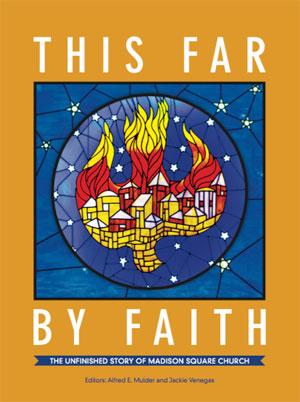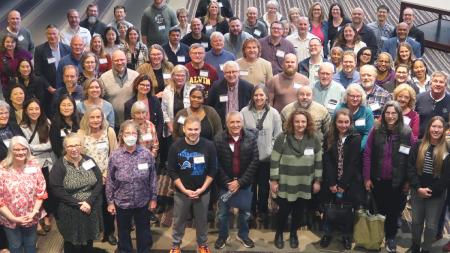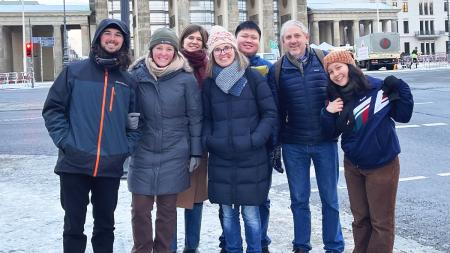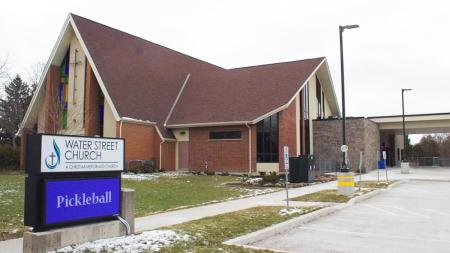New Book Recounts Pioneering History of Madison Square CRC

The idea of writing a history of Madison Square CRC in Grand Rapids, Mich., began when the congregation marked its centennial in 2014.
Initially, organizers for the 100-year celebration thought a small booklet would suffice. It could provide highlights sketching the church’s growth from one of the first CRC mission stations to a chapel to a large church with multiple sites.
But then, as historical documents and boxes of information and stacks of photos came in, they decided that a book was in order.
“We had no idea then that it would take two-and-a-half years to get it done,” said Al Mulder, a long-time Madison member and coeditor of the newly published This Far by Faith: The Unfinished Story of Madison Square Church.
For all of the work, he and coeditor Jackie Venegas are pleased with the finished product, a 239-page compilation of photos and stories spanning more than a century and featuring a church that has been a pioneer in many areas throughout its history.
Madison Square has been a groundbreaking congregation in the way it has grappled with and has been able to wed mission with church life — essentially word and deed — and in the process it has become a viable multiethnic congregation, said Mulder.
Madison Square was one of the first CRC congregations to open itself to the leadership gifts of women, and the church has worked hard within itself and with other congregations toward racial reconciliation.
The arts and drama have also been important, and spirit-filled music and engaging worship have been part of an evolving program of meeting the needs of church members and people living in the community, said Mulder.
The book reveals the story of the church with its triumphs and failures -- for instance, recounting a struggle at one point over whom to hire as a youth minister and recognizing the pain it caused and yet what the congregation learned from it.
Written by various authors and woven together smoothly by the editors, stories about each of the time periods the church has lived through help to put those eras of church life into perspective.
An example is at the start of Chapter 4, titled “Radical Change and a New Direction.” Before telling the story of Madison during the late 1950s and into the ’60s, writer Bob Schuyler sets the scene by recounting for the reader what was going on as these “years brought radical social change throughout the United States.”
He writes about the civil rights movement and mentions the unforgettable five-year period in which John F. Kennedy was assassinated in 1963, “the Watts community in Los Angeles was decimated by riots in 1965, the destructive five-day 12th Street riot [erupted] in Detroit in 1967, and Dr. King and Robert Kennedy were assassinated in 1968.”
After touching on how these events were shaking the country, the writer zeroes in on ways in which this also was a period of significant change in the church.
We read how Madison members were still worshiping in their chapel and had to address the reality that its neighborhood was being transformed — and with that the church faced major challenges.
Welcoming a trickle of black families, Madison had to address a twofold challenge: transitioning from a dependent chapel to a self-supporting church, and from the leadership of an evangelist to an ordained minister to help make it happen.
This change did occur, and the church was organized in 1970. It did not move from the chapel building to its current church building until 1979.
“At one of its most pivotal moments, when its first black families were being welcomed into full fellowship of congregational life, chapel leaders were suddenly forced to make a difficult decision,” and they became self-supporting, writes Schuyler about this time.
“Whether this challenge came as a result of the supporting churches’ reservations about multiracial ministry cannot be determined, but the timing was significant.”
Besides these slices of local and national history, the book offers such stories as how the newly organized and struggling church had no money to pay a mover to bring their new pastor, Dave Sieplinga, from Omaha to Grand Rapids. So three Madison members rented a truck and drove through a snowstorm to get their new pastor.
The same thing happened a year later, in 1978, when the church called Dante Venegas and his wife, Jackie, to serve the congregation, and this time Sieplinga was one of the movers. When the Venegas couple arrived, the church had started to settle into its new building.
The new book looks at the church's early embrace of Christian community development, touching on what became Vinedresser Ministry, which was independent of Madison but with its help began programs for single mothers, a program for young fathers who weren’t parenting their children, a club for boys to help them stay out of gangs, a group to help struggling writers, and a consultation process on racial reconciliation.
Throughout, like any rich congregational history, the book unfolds the stories of its ministers, copastors such as Dante Venegas (deceased), who was a black Puerto Rican, and Sieplinga, and then David Beelen, who are white.
It also features artists who crafted banners for worship, the construction of a new sanctuary in 1991, a drum circle ministry featuring a range of drums, and an expanding prayer ministry that offered a simple process for people to use when they were seeking healing.
All in all, the book accomplishes what the editors and authors set out to do. Guiding principles, said Al Mulder, included, first, “that the story be less about Madison’s centennial and more about God’s faithfulness.
“A second guiding principle was to place less emphasis on an exhaustive history with people, places, and dates and more emphasis on unique ministry within God’s Madison story.”


